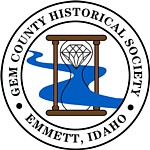Martinsville, 1864 - 1870
.jpg)
click image to enlarge
Excerpts from "The Village That Grew" by Ruth B. Lyon, 1979, Early Settlers Profiled in Chapter 2 (p. 13-43):
John F. Basye and Mary Albertine Basye - p. 16
In 1863, the John F. Basyes (Mary Albertine Basye), their two sons, Lisbon and David, and daughters, Josephine and Miranda (who became the wife of Aaron Bascom) moved to Centerville (Boise County), Idaho, where Mr. Basye purchased the Pioneer Mining Ditch and began operating a sawmill.
About 1866, the Basyes moved to Martinsville, and John F., with his son-in-law, Samuel Walker, constructed Martinsville's first sawmill in 1870. It was located near the river. This was an important development because the need for building and fencing was increasing as the area developed.
(Doc) William Burdge Family- p. 29
In October of 1864, (Doc) William Burdge and his emigrant outfit, the finest equipped that ever entered the village, came grinding down the Camel's Back into Payette Valley. He brought the first Roan Durham cattle and Morgan strain horses to Idaho.
The Burdges, like most of the valley pioneers, settled near the river. They purchased part of the Block House Ranch located two miles west of Martinsville. The north side of the property extended to the river enabling Mr. Burdge to build a private ditch . . .
In 1874, he hauled stone grinding wheels from Eagle and set up a grist-mill. The stones came originally from Canyon Hill northwest of Caldwell. (see grinding wheel photos)
Lorenzo and Louisa Gill - p. 13
After selling their "stopping place", Lorenzo and Louisa Gill took up land on the across the Payette River and were probably the first to settle on the north side of the river. . . Mr.Gill, a polished Missouri gentleman, was always dressed up. . .
Nathaniel Martin - p. 38
The Nathaniel Martin homestead lay east of Jonathan Smith's. Nathaniel ran the ferry and Jonathan, the hostel. The ferry operated mostly in high water season, although the account book showed listings for all months of the year. . .
Nathaniel took up his homestead along the river on October 11, 1872, almost nine years after his arrival in the valley. . . Mr. Martin was known as "The Squire." He performed weddings and acted as Justice of the Peace; he also took care of the mail which was left at the Junction House until the Martinsville Post Office was established in 1867. . .
Joseph C. Shepherd - p. 34
In the spring of 1863 Joseph Shepherd was busy carrying the first express for Tracey and Company of Portland, Oregon, over the Umatilla-Placerville Trail. J. C. Shepherd and his family settled about a half mile southwest of the Smith-Martin hostelry. Joseph drove stage between Falk's Store (Payette County) and Placerville (Boise County) for several years. . .
The Shepherds donated land for Emmettsville's first school which stood on the south side of West Fourth Street . . . (it became known as) "Shep's School."
Jonathan Smith Family - p. 38
An interview with Jonathan Smith, printed in the "Index" of 1896 and excerpts from Ollie Emison story related in "Pioneer Days in Malheur County" tells us that
Jonathan Smith, his wife, and two daughters, Nancy and Sarah, and Nathaniel Martin came west in 1861 with ox teams from northern Missouri. They left due to the Civil War, law and order had broken down. . . They joined a wagon train and traveled west until they came to Burnt River, Oregon, where Jonathan mined. In 1863, Smith and his pardner Nathaniel Martin traveled up the Basin Trail in search of better mining prospects . . .They located near the present Emmett bridge. After Jonathan built a cottonwood log cabin, his family came from Burnt River and moved into their pioneer home. Jonathan kept busy helping his pardner build the ferryboat and hostel.Nancy married George Brinnon who operated the Washoe Ferry on the Snake River near the present town of Payette . .
Alex Womack - p. 37
Another early-day settler was Alex Womack, a Missourian, who had been a soldier in the Civil War. He arrived in Idaho in 1870 and went to Anderson Creek above Martinsville. There he placer-mined for gold which enabled him to send for his wife and children.
Alex soon filed on land in Martinsville. Part of the legal description of Jonathan Smith's property states that it ran to the southeast corner of Womack's land and from the Nathaniel Martin land to the center of the road near Womack's blacksmith shop. The shop, built in 1870, was located at the north end of Commercial Ave, where the present depot stands. . . .
Copyright © 2008 - All Rights Reserved.
Unless otherwise attributed, all photos and text are the property of Gem County Historical Society
Serving Gem County since 1973.
Hours
Wednesday - Saturday 1:00pm - 5:00pm
& by appointment :: Extended hours during The Cherry Festival in June.
